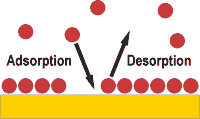Surface chemistry: Deals with phenomena that occur at the surfaces or interfaces
Adsorption:
⇒ Surface phenomenon
⇒ Accumulation of molecular species at the surface
⇒ Adsorbate: the substance that accumulates at the surface
⇒ Adsorbent: the material on the surface of which adsorption occurs.
⇒ Adsorption α Surface Area
Desorption: The process of removing an adsorbate from the surface on which it is adsorbed.

Differences between adsorption and absorption
|
Adsorption |
Absorption |
|
|
Definition |
Assimilation of molecular species throughout the bulk of the solid or liquid is termed as absorption. |
Accumulation of the molecular species at the surface rather than in the bulk of the solid or liquid is termed as adsorption. |
|
Nature |
It is a bulk phenomenon |
It is a surface phenomenon. |
|
Heat exchange |
Endothermic process |
Exothermic process |
|
Temperature |
It is not affected by temperature |
It is favoured by low temperature |
|
Rate of reaction |
It occurs at a uniform rate. |
It steadily increases and reach to equilibrium |
|
Concentration |
It is same throughout the material. |
Concentration on the surface of adsorbent is more than in the bulk |
Types of adsorption:
1. Physisorption: when a gas is adsorbed on a solid by weak Van der Waal’s forces
Characteristics:
⇒ Non-specific – no preference for a particular gas
⇒ Reversible
⇒ Enthalpy of adsorption is low (20 – 40 kJ/mol)
⇒ Easily liquefied gases are adsorbed easily
⇒ Low temperature is favourable
⇒ Increases with increase in surface area
⇒ No appreciable activation energy is required
⇒ Results in a multi molecular layer on adsorbent under high pressure
2. Chemisorption: when a gas is adsorbed on a solid by chemical bonds (covalent or ionic).
⇒ Highly specific – occurs only when there is a possibility of forming a covalent bond between the adsorbate and the adsorbent.
⇒ Irreversible
⇒ Enthalpy of adsorption is high (80 – 240 kJ/mol)
⇒ High temperature is favourable
⇒ High activation energy needed sometimes
⇒ Increases with increase in surface area
⇒ Results in unimolecular layer
